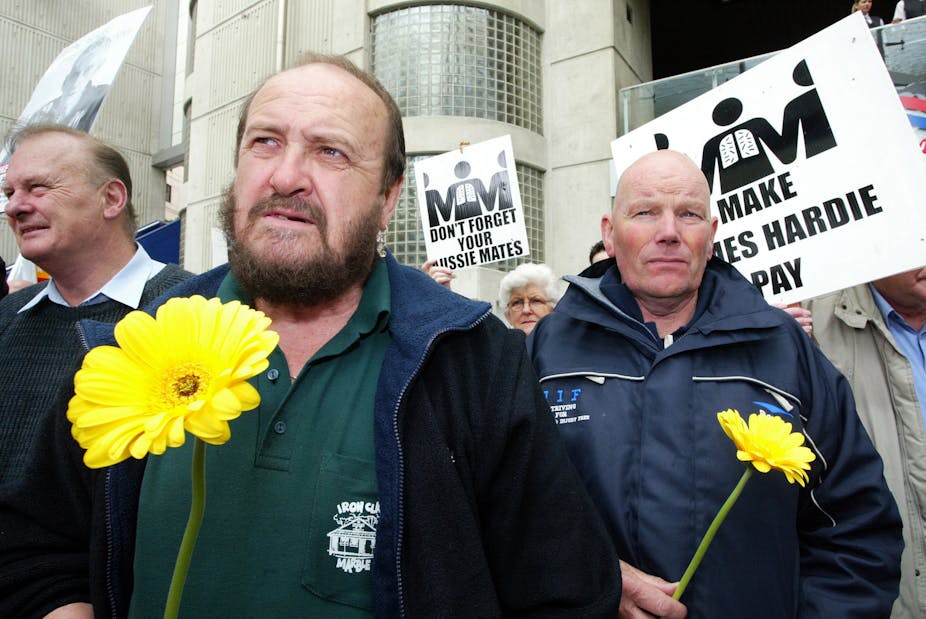The toxic health effects of asbestos have been a prominent feature of the Australian industrial landscape for decades. The not-insignificant financial responsibility for asbestos-related compensation claims came to a head with the corporate reorganisation of the James Hardie group beginning in 2001 with the quarantining and subsequent isolation of asbestos liabilities in Australia.
Recent media attention on Telstra has once again put the spotlight on funding compensation for asbestos claims. The focus is on the pits that Telstra built for the NBN that, in a strange twist of fate, are lined with asbestos manufactured by James Hardie.
Telstra has already shouldered some responsibility for workers who contracted mesothelioma from the original construction of these pits, and now finds itself embroiled in controversy over potential new claims emanating from the NBN rollout.
But calls from unions for Telstra to establish a James Hardie-style compensation scheme may not be in the best interest of future claimants. The funding arrangements are not straightforward and James Hardie is not required to fund claimants directly. Instead the contributions are inextricably linked to James Hardie’s accounting numbers from financial reports as outlined in the Amended and Restated Final Funding Agreement (AFFA).
Following protracted negotiations between James Hardie, the NSW government and the trade union representative, Bernie Banton, this agreement was struck to ensure both the financial viability of the James Hardie group in the face of significant asbestos liabilities, as well as ongoing funding for asbestos claimants.
The Asbestos Injuries Compensation Fund (AICF) was established as the administrating body in the role of trustee over the AFFA. Despite the fact that James Hardie does not own or control the AICF, under accounting regulations the James Hardie Group is required to include the AICF in its financial statements. This is where the mystery of accounting practices and the numbers they generate begins.
As the corporate parent, James Hardie records a A$1,625,400 million asbestos liability on its balance sheet and, in addition, makes negative asbestos adjustments of A$117.1 million in comprehensive income to reflect the movement in the asbestos liability estimate for the year ending 31 March, 2013. These figures represent the AICF’s financial numbers and, while it is true that these figures are recorded in the financials of James Hardie, they do not represent the amount that James Hardie is required to pay at any point in time.
Therefore, media reports that claim “James Hardie will be forced to pay more than $100 million extra” are misinformed and provide a false sense of security to asbestos victims and their families. James Hardie does contribute to the AICF, but is only required to fund the AICF subject to a complex formula that effectively caps James Hardie’s annual contribution to 35% of its “free cash flow” - another figure derived from James Hardie’s financial statements.
It is not based on increases to the estimates of asbestos liabilities of just over $100 million explained previously. More importantly, James Hardie states in its annual report that it does not “anticipate making a contribution to AICF in respect of the year ended 31 March 2013”, despite having paid US$188.5 million in dividends to shareholders in the same year.
This style of separate trust scheme to fund claims has been employed in other jurisdictions with different compensation regimes such as the US, with limited success. In many cases claimants are paid only a proportion of their claims. But without such schemes, many victims of asbestos exposure would have been left completely adrift without recourse to even limited compensation due to corporate bankruptcies.
In Australia, James Hardie presented a unique case and the compensation scheme evolved to suit the peculiarities of its operations, stakeholder pressures and the willingness of for the government to intervene. The corporate reorganisation that commenced in 2001 and culminated in the move to the Netherlands cast doubt over the life-line of funds left in Australia.
And, because of its virtual domestic market saturation for asbestos products, James Hardie is named as a defendant or a co-defendant in the majority of asbestos claims, therefore there are numerous stakeholders reliant on James Hardie to provide funding.
With the potential failure of the initial arrangements to provide funding after the reorganisation and fearing that ongoing funding was at risk, the NSW government provided the framework to develop the scheme with the aims of preserving the financial viability of the company and appeasing the concerns of all stakeholders. Other prominent companies with asbestos liabilities, such as CSR Ltd and Telstra, are not in the same league, in terms of exposure to claims. As long as the AICF is able to fund present and future claimants, any claims against Telstra from James Hardie products could be encompassed under the James Hardie scheme.
Therefore, before the Australian government is persuaded to agree to any more one-off corporate-based schemes to fund asbestos claims, consideration should be given to the detail of the scheme and whether contributions to such a scheme based on nuanced accounting numbers are appropriate. This caution should also be exercised by commentators, who seem to have forgotten that several governments have had to provide loan facilities to the James Hardie scheme so that the AICF is able to provide the corrective justice victims seek from financial compensation.

